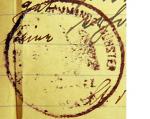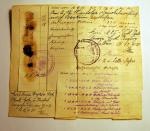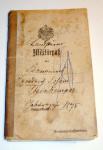-
Posts
5,629 -
Joined
-
Last visited
Content Type
Profiles
Forums
Blogs
Gallery
Events
Store
Everything posted by IrishGunner
-
Uwe, vielen dank! Fantastisch! Only two more pieces to the puzzle. From these excerpts, it appears that Kanonier Steinkemper did some kind of service in the Reichswehr, 29.4.19 to 13.4.20 In this piece he receives a coat, pants, and boots from what seems to be Bekdo. XXX for the year. Hxx beim Bezkdo XXX Rock, Hose, Stiefel xxxxx vom 29.4.19 X 13.4.20
-
Bob, Indeed, comparing letters to other already deciphered words is a great hint. I was pretty sure the abbreviation was "bayr." for bayerische - Bavarian - as you suggest. But it was exactly the same word that stumped you that has given me the most trouble. In other entries, I can figure out context, but this one has me totally perplexed. Now that my eyes are rested, I will go attack it once more. 1500+ pages on the Prussian artillery! Where is the envious drooling smiley face icon? Four copies? Happy to help with your grand-father in any way I can... :beer:
-
Karsten; thanks! These are great additions to the thread. I appreciate the photo and document. Hopefully, I will be able to add such items to my collection. Unfortunately, I do not have more info on the regiment. I am searching out info on other regiments and am always on the look-out for more history and will keep you in mind for this period. Maybe I will one day be able to snag a regimental history.
-
Bob, these officers were gleaned from the internet. I do not have any Ranglisten. I am just starting these regimental histories; based upon what I can easily find. Certainly, there is more info out there; I am just not sure where I should draw the line. At some point in the future, I may start a website representing all regiments of the German Imperial artillery. I just am not sure what I would want each page to look like. At this point, I am just fascinated by whatever I can find...
-
I have finished my first translation/study of a Militärpass; a simple soldier. Forty-one year old Friedrich Johann Steinkemper, married with two children, entered military service on 22 December 1916 as a Landwehr recruit. A machinist from Beckum in Westphalia, Steinkemper was entered into the rolls as a kanonier in Fussartillerie Regiment Nr. 7, garrisoned in nearby Köln. At the beginning of 1917, he was transferred to Landwehr Fussartillerie Battalion 32; spending three months with 6. Batterie before being assigned to the Battalion's 4. Batterie. For unknown reasons, a stamp from Fussartillerie Battatlion 57 appears in his Militärpass on the page assigning him to 4. Batterie Fussartillerie Battalion 32. From April to August 1917, Steinkemper saw his first combat during battles along the Yser River and in Flanders. From August to September 1917, he returned to the Ersatz Battalion, Fussartillerie Regiment Nr. 7. He saw duty at the front for only a week with 2. Batterie Fussartillerie Regiment Nr. 7 before he was re-assigned to 1. Batterie Fussartillerie Battalion 29. Steinkemper spent the remainder of the war with Fussartillerie Battalion 29, seeing action during the final battles of 1917 in Flanders. In 1918, Steinkemper and Fussartillerie Battalion 29 fought with the 9. Reserve Division against the British from the „Große Schlacht in Frankreich“, through battles in Artois and French Flanders, to the Retreat from Antwerp and Maas. Kanonier Steinkemper was a simple soldier; never promoted and never decorated. He survived the war without being wounded, although he spent a week in the hospital in September 1918 with an unknown illness. Steinkemper was demobilized by Fussartillerie Regiment Nr. 7 on 2 December 1918; on 7 December he was given a train pass to return to his family at Grûner Weg 11, Beckum, Westphalia.
-
A few new bits of info regarding Fuss-Artillerie Regt Nr. 1 ... adapted from http://www.lexikon-der-wehrmacht.de/ The following Wehrmacht generals started their military careers or served during WWI in Fuß-Artillerie-Regiment von Linger (Ostpreußisches) Nr.1. Generalfeldmarschall Milch, Erhard; Erhard Milch entered Fuß-AR 1 as a Fahnenjunker on 24 February 1910. In autumn of the same year, he became a Fähnrich and received an appointment as a lieutenant on 18 August 1911 in the same regiment. He assumed duties as a battery officer; however, in the summer of 1915 he transferred to the Fliegenden Truppe and was assigned to Artillerie-Flieger-Abteilung 205. He subsequently served as Adjutant of the Artillerie-Fliegerschule Ost and several different flying units. During WW I he earned both the Iron Cross First and Second Classes. On 1 February 1939, Milch became the Generalinspekteur der Luftwaffe, a position he held until 1945.. Generalleutnant Usinger, Christian; Christian Usinger volunteered for military service on 1 August 1914 as a Kriegsfreiwilliger, joining Fuß-AR 1. He reached the rank of lieutenant in 1915 and served with the regiment throughout WWI. In the summer of 1939, he was given command of an artillery regiment. He held several higher level artillery commands during WWII and assumed command of the 223. Infantrie Division on 20 October 1942. He also commanded the 81. Infanterie-Division for a period in 1944. He ended the war in command of I. Armee Korps on the Eastern Front. General der Artillerie Lucht, Walther; Walther Lucht joined Fuß-AR 1 as a Fahnenjunker on 27 June 1901; by October 1911 he had achieved the rank of Oberleutnant and served with the regiment's 8. Batterie in Lötzen. On 1 January 1913, he assumed the position of Regimental Adjutant; later that year, he assumed command of the Kriegsakademie in Berlin. With the beginning of WWI, he returned to the regiment as a battery commander. He received the Iron Cross Second Class on 4 November 1914; and later also the Iron Cross First Class. In 1916, he left the regiment and served on various headquarters staffs. At the end of WWI, he was serving on the staff of 75. Reserve-Division. Prior to the outbreak of WWII, he served as Artillery Commander for the Condor Legion in Spain, earning the Medalla de la Campaña de España, das Cruz de Guerra de España und das Spanienkreuz in Gold mit Schwertern. At the beginning of WWII, he commanded Artillerie-Regiment 215 and held several artillery commands early in the war. He assumed command of 87. Infantrie-Division on 17 February 1942, but only held that command for a short time before assuming command of 336. Infantrie-Divsion on 1 March 1942. He later commanded the LXVI. Reserve Korps, the LXVI Armee Korps, 15. Armee (during the Ardennes Offensive), 11. Armee, and the XII. Armee Korps.
-
I just googled Emilie Caldwell Stewart. Wow; this book sounds exactly what I am talking about for WWI-era Militärpass. "Wehrpass; 1994. This book was limited to 1000 copies. Soft cover and large 8.5 x 5.5 format, my reference book contains over 150 examples of original Wehrpass pages and beneath each reproduced page is a guide to what information is found on that page. My book helps you easily decipher Wehrpasses in your collection. Many of the examples were provided by the original German soldiers who were issued the Wehrpasses. Each page is fully described, translated and with codes deciphered. All branches of service are included. The back has a separate glossary of common abbreviations and medical codes found in Wehrpasses. This glossary cannot be found in any other reference book. Out of print." I wonder how similar WWII Wehrpass are to WWI Militärpass? If this book would be helpful... 1000 copies; out of print. :banger:
-
Has anyone made their own tool to help with deciphering Militärpass? I mean something that has translated the different sections of the document; the standard printed sections - not the written entries. I speak German and can read the printed script fairly easily and am thinking of developing such a tool. But don't want to do work that maybe someone has already done and is willing to share. (David of www.militaerpass.net perhaps?) I am also not talking about something to help decipher the hand-written script entries; that's a whole different story. Not easy in any case, but I am thinking with a tool that helps with the printed text, it makes laboring over the hand-writing a bit easier.
-
I wondered more about the colon " : " after BMBR than the L's. I haven't seen that before; but that doesn't mean a darn thing. I would think it odd to fake a common rank/name/regiment; but anything is possible.
-
Absolutely, stand corrected on Bombardiers. And I should have known better since I have WWI medals representing all ranks of the RA! I answered too quickly and had a few Guinness. :cheers:
-
Noor; RFA = Royal Field Artillery RA = Royal Artillery The Royal Artillery consisted of the RFA, RGA (Royal Garrison Artillery) and RHA (Royal Horse Artillery) RFA is the field artillery - the lighter guns in direct support of the infantry RGA is the heavy artillery - the bigger guns at corps and army level RHA is light artillery serving with the cavalry A BMBR = Acting Bombadier; a rank equal to acting corporal in other arms like the infantry The Ubique badge is the regimantal badge for the Royal Artillery The other badge you have; British Legion = is a veterans organization You can download the Medal Index Card from the UK archives for 2 Brit Pounds; this will show you the medals he to which he's entitled. http://www.nationalarchives.gov.uk/documentsonline/medals.asp
-
1) I'm only part Irish (one grandmother), but not Catholic. 2) Almost all are Bavarian that I have seen; except for the one Wuerttemburger and one Italian I've snagged. 3) Oh, I've already strayed from only artillery - the Wuerttemburger for example is not a gunner and I have a couple Bavarian infantrymen, which could be tradeable ;-) So, what's the most you have spent for one? :whistle:








